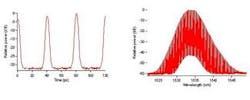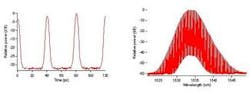Pulsed lasers improve WDM testing
Mode-locked erbium-glass lasers are ideal for component, subsystem, and system test and measurement applications.
Michael Brownell
GigaTera Inc.
Test and measurement equipment must keep up with the evolving needs of network engineers cost-effectively. Pulsed lasers based on mode-locking produce very high quality pulses for test applications such as impulse response testing, fiber dispersion measurement, and receiver qualification. Mode-locked lasers also have the unique property of producing a highly stable comb of wavelengths, which can be separated by precise WDM channel spacings and locked to the ITU grid. This enables new and efficient methods for WDM multi-channel testing and frequency metrology. These sources are cost-competitive and provide superior performance with a reduction in complexity and size.
Pulsed lasers produce multi-wavelength output
Optical pulses from a laser are generated via mode locking, where the multiple modes in the laser cavity are phased locked together. Each of these optical modes is a discrete wavelength, and they add together coherently to produce precision pulses in time. A continuous stream of these highly stable optical pulses can be produced with this method, making an ideal RZ source.
The optical spectrum for this type of laser is a broad comb of wavelengths at precision spacing with narrow linewidths. A key property is that the pulse repetition frequency is equal to the spacing between adjacent wavelengths. This allows a well-designed mode-locked laser to be used as a either a multi-wavelength source or an RZ source.
Mode-locked lasers designed for 1.5-µm operation include the fundamentally mode-locked erbium glass laser, harmonically mode-locked fiber ring lasers, and semiconductor approaches. Fundamentally mode-locked lasers operate directly at repetition frequencies and wavelength spacings such as 10 GHz, 25 GHz, and 40 GHz. Harmonically mode-locked lasers operate at lower frequencies, have additional spectral components, and are more complex. Passive mode locking is a way to generate optical pulses without any external drive signal, whereas active mode locking requires RF drive electronics.
The erbium glass laser is a passively and fundamentally mode-locked optical source, which generated the pulses and multi-wavelength spectrum shown in Figure 1. The pulses are at a repetition frequency of 25 GHz with widths of 3.4 psec and average power of over 10 dBm. The cavity length is about 6 mm, making the device compact, simple, and scalable into test instruments and network applications. Timing jitter is less than 100 fsec when synchronized to an external clock and the contrast ratio is over 30 dB.
The spectrum is a comb of channels at 25-GHz spacing with linewidths of less than 1 MHz and optical signal-to-noise ratios as high as 60 dB. The total number of spectral lines coming directly out of the laser is well over 50, which can be filtered down to meet lower channel count requirements or further broadened with available fiber to cover broader spectral ranges. Recent applications tests were done using a dynamic gain equalizer and an EDFA to produce over 32 channels at 25-GHz spacing with signal-to-noise greater than 35 dB and flat to a few tenths of a decibel. This spectrum is highly stable and can be locked to the ITU grid with a standard wavelength locker.
WDM test and applications
There are numerous critical parameters in WDM systems that need to be tested at the system and component levels. Performance and stability measurements on multiplexers, demultiplexers, optical fiber, optical amplifiers, transmitters, and receivers are all key to development, manufacturing, and deployment of WDM systems.
The multi-channel spectrum from mode-locked lasers like the erbium glass device allow many channels to be tested simultaneously for parameters including polarization-dependent effects, chromatic dispersion and stability, amplifier performance, and noise figure. The comb of channels can be locked to the ITU grid and used as a precision reference for low and high channel count systems.
Automated testing and environmental qualification are typical in manufacturing applications, which are required to be efficient and stable. A single compact source capable of producing multiple channels is an advantage in these cost-sensitive applications. Field testing of WDM systems is currently limited to single-channel and/or single-laser testers. WDM system testing for bit-error rates, losses, drift, crosstalk, and various dispersions must be done on multiple channels, which poses practical and economic challenges. The multi-wavelength laser can be used as a channel reference for system tests in metro applications, link qualification, and in frequency metrology.
Any device or system under test must be fed with an optical signal of known characteristics so results can be analyzed and understood. The precision spectral spacing, high optical signal-to-noise, and small footprint make the erbium glass mode locked laser a useful new reference tool in the kit of a WDM test engineer.
Mode-locked lasers have long been used for their ability to produce high-power pulses with short time durations. When designed properly the pulsed laser can be made to operate such that each pulse comes out with the same amplitude and duration. This precision performance allows the pulsed laser to be used for impulse response testing to measure rise and fall times, response times, and system performance. The mode-locked laser is an effective pulse reference with known performance and stability. Fiber dispersion is a common measurement made with such reference pulses.
New developments such as supercontinuum and spectral broadening open additional applications for pulsed lasers in test and measurement. Sending relatively high peak power pulses into special fiber types generates spectrums much broader than the laser itself produces. Supercontinuum spectrums covering 300 nm have been demonstrated with the erbium glass laser. This span represents over 1,000 WDM channels separated by 25 GHz, which covers more than the C, L, and S bands combined. This technique can also be used to fill just the C-band with channels, or to make a 10-nm spectrum that is tunable.
The erbium glass mode-locked laser is an effective source for test and measurement applications in both the time and frequency domains. WDM system development, manufacturing, and field testing will benefit from the unique properties of these lasers. The compact size allows them to fit into the module form factor common in test instruments and they are simple and cost-competitive, which is a fundamental requirement in today's marketplace.
Michael Brownell is vice president, product development at GigaTera Inc. (Dietikon, Switzerland).

